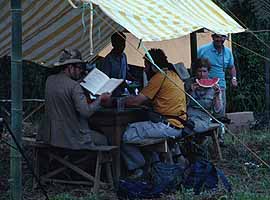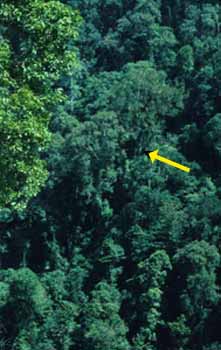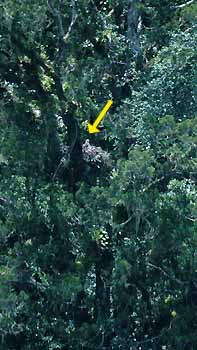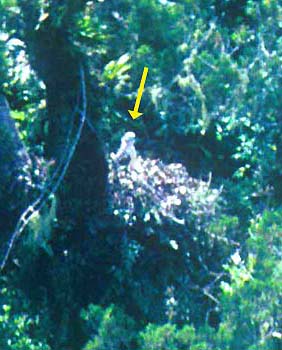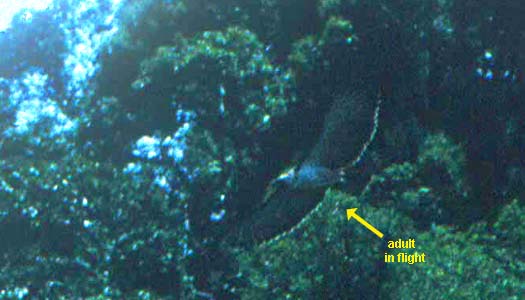|
a photo discussion by Don Roberson
|
|||
| GREAT PHILIPPINE EAGLE
Pithecophaga jefferyi
Mt.
Katanglad, Mindanao, Philippines
|
|||
In choosing the "best bird" in the world, I use the same criteria that
I adopted in my youth when I researched, weighed, balanced, and created
my own "top 50 birds of the world." These criteria were:
My visit to Mt. Katanglad was part of a KingBird Tour, led by Ben King, in late February 1990. There the six participants and Ben King stayed in a small camp at the edge of the forest built by Tim Fisher for a tour he was to lead a few weeks later. Just before we left to fly to Manila, this FAX arrived from the KingBird office: "We will camp for four nights in northern Mindanao near the site of an active Monkey-eating Eagle nest. We'll supply tents, food, etc. You will need to bring a sleeping bag and air mattress." 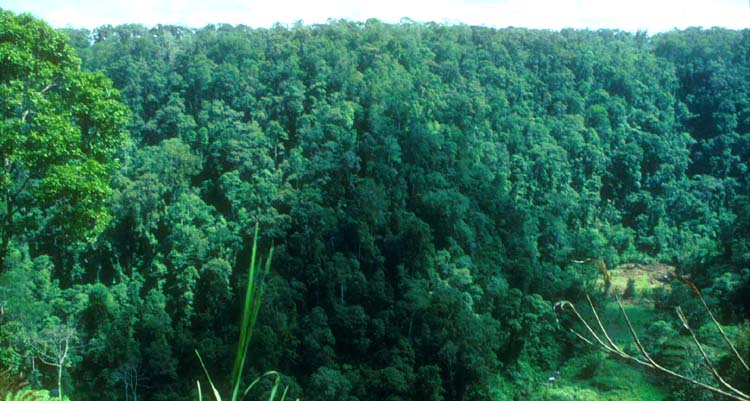 |
|||
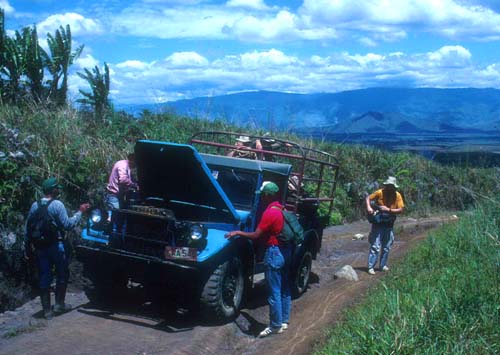 To
reach the camp we flew to Caguyan de Oro on Mindanao. Then took a bus to
a rough dirt track, shifted the gear into a jeep, and followed the four-wheel
drive ruts up to the camp at 4500' elevation, stopping to repair the jeep
as necessary (left). The general location was near Dalwangan, north of
Malaybalay, Bukidnon Province. The eagle nest was across a deep valley
(above) from our camp site (in the forest to the right of this photo).
We had views of the eagle nest and a 1.5-month-old chick from an overlook
on our side of the ravine. One day I hiked down to the valley floor (4100')
and saw an adult eagle fly overhead and up towards the nest. On another
day, I waited at our observation perch until an adult arrived at the nest
and tear up something for the mildly-interested youngster, and on yet another
day I photographed an adult flying overhead and up the valley toward the
hills. The valley itself, and all lower elevations, were badly degraded
by slash-and-burn practices. We heard chainsaws going from dawn to dusk.
I have since learned that the area in which our camp was located has been
cut down. To
reach the camp we flew to Caguyan de Oro on Mindanao. Then took a bus to
a rough dirt track, shifted the gear into a jeep, and followed the four-wheel
drive ruts up to the camp at 4500' elevation, stopping to repair the jeep
as necessary (left). The general location was near Dalwangan, north of
Malaybalay, Bukidnon Province. The eagle nest was across a deep valley
(above) from our camp site (in the forest to the right of this photo).
We had views of the eagle nest and a 1.5-month-old chick from an overlook
on our side of the ravine. One day I hiked down to the valley floor (4100')
and saw an adult eagle fly overhead and up towards the nest. On another
day, I waited at our observation perch until an adult arrived at the nest
and tear up something for the mildly-interested youngster, and on yet another
day I photographed an adult flying overhead and up the valley toward the
hills. The valley itself, and all lower elevations, were badly degraded
by slash-and-burn practices. We heard chainsaws going from dawn to dusk.
I have since learned that the area in which our camp was located has been
cut down. |
|||
|
|||
| The Philippine Eagle nest was in huge tree across the valley (left below) and a telephoto lens was necessary to even show the chick (right-hand photos below). | |||
|
|||
| The latter shot (above) is enlarged and shows a feathered chick still
mostly white but already sporting brown upperwing covers. Adults raise
only one young a year, bringing them a variety of food, including monkeys
snatched from treetops. But as the habitat is lost, so is the necessary
prey base. The loss of habitat — along with the shooting and trapping of
the eagles — are the primary threats to its continued existence.
Captive breeding has been attempted (in fact, I was once on the board
of a Philippine Eagle Fund that raised money for this purpose) but has
not had much success to date (although I am not up on the most recent news).
Political instability and insurgents in the back country of Mindanao have
seriously interrupted efforts to save the eagle. The outlook is fairly
bleak. It has been difficult to obtain any reliable information about the
number of birds that still survive because its habitat is so remote and
the bird difficult to locate away from a nest. Each adult hunts over a
huge section of forest. The most recent estimates I heard in 1990 were
in the low hundreds. A much more recent paper puts the number on Mindanao
at between 82 and 233 (Bueser et al. 2003).
|
|||
| These shots of the adult are not the greatest photos in the world, but do show the massive wingspan and the huge bill. It was surely a major highlight to see such a fabulous bird in the wild. | |||
 |
|||
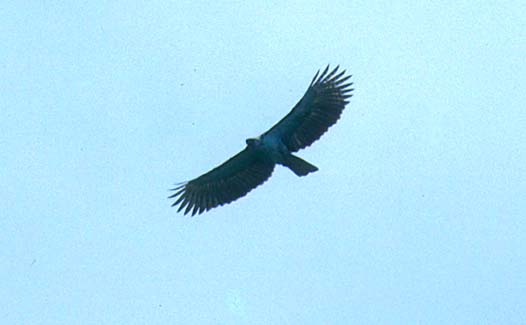 This
(left) was my only really half-decent shot of the adult as it soared up
and over my head, heading for distant ridges. This
(left) was my only really half-decent shot of the adult as it soared up
and over my head, heading for distant ridges.
I still consider the Great Philippine Eagle as the "best bird" in the world. The day I finally saw a Philippine Eagle — coming to a nest on Mt. Katanglad on Mindanao — was among the happiest and saddest days of my life. Happy, because I had finally experienced such a magnificent bird in the wild, but sad, because one could hear chainsaws cutting at the edge of its forested home from dawn to dusk every day we were there. We can only hope that it will survive for others to enjoy, and to continue to fulfill its part in the chain of life's biodiversity. |
|||
Literature cited:
Bueser, G.L.L., K.G. Bueser, D.S. Afan, D.I. Salvador, J.W. Grier, R.S. Kennedy, and H.C. Miranda, Jr. 2003. Distribution and nesting density of the Philippine Eagle Pithecophaga jefferyi on Mindanao Island, Philippines: what do we know after 100 years? Ibis 145: 130-135.TOP |
